#orkney clan
Text
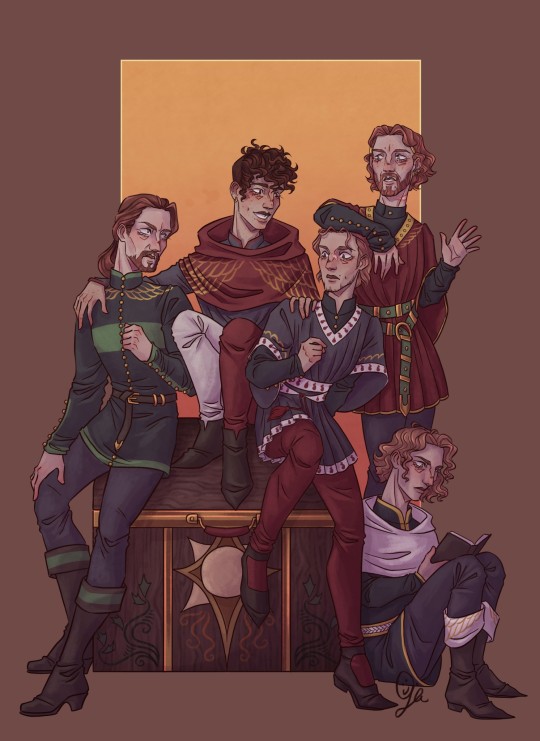
An army of gingers, and Gareth. Honestly mad respect to literally all of the orkneys being menaces in different ways.
#the orkney clan#the orkney brothers#gawain#agravain#gaheris#sir gareth#sir gawain#mordred#arthuriana#art#dionysus draws
117 notes
·
View notes
Photo

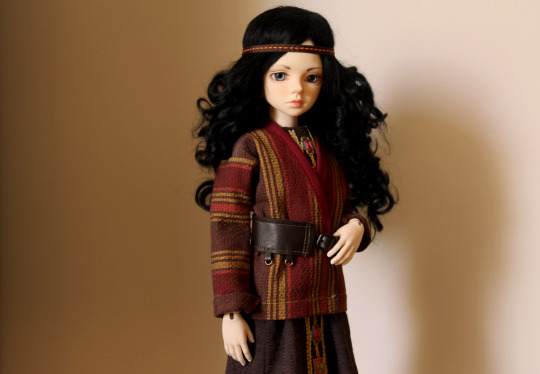
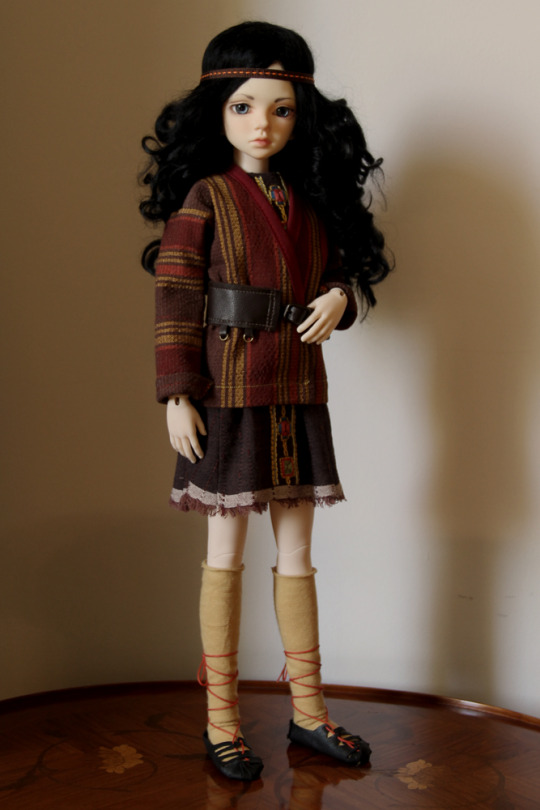
I’m ready to show Agravain to the world XD!
I have a real love-hate relationship with this doll. His expression is exactly what I want from a Boy Agravain, but his eeeeeyes are so laaaarge. The eye thing didn’t strike me when I bought him - I adored this sculpt - but in the meantime I’ve realised that pretty much all my dolls have a more realistic eye size and D.i.M. Jullis is the odd one out.
Agravain’s tunic is a bit short because he’s growing quite fast... Morgause will need to make him a new one soon!
*I* still need to make him a small dagger and scabbard to hang off his belt.
So - that’s three out of four Orkney boys done! Only Gawain still left to dress. Of course he is the most difficult. I don’t have a clear notion of the look of his clothes yet...
#agravain#agravaine#sir agravain#orkney bros#agravain of orkney#Knights of the Round Table#ball-jointed doll#ABJD#little knights#children of the round table#clan gawain dolls#dim jullis#doll in mind#myou doll#hybrid
32 notes
·
View notes
Text
The Orkney Brothers as D&D classes:
Gawain - Fighter (Battlemaster subclass)
Agravain - Rogue/Wizard multiclass (Inquisitive/War Magic subclasses)
Mordred - Paladin (Oath of the Crown - specifically for the mechanical subtext)
Gaheris - deliberately sub-optimal cleric/barbarian/fighter multiclass
Gareth - Fighter (Champion subclass)
Nonsensical rambling about class choices under the cut.
I thought about the cavalier subclass for Gawain, but given that he’s the eldest son of a king and and fought in at least one war as well as fending off Saxon raids, I feel like battlemaster is the best fit -- not in the sense that he’s a tactician, he’s not, but he’s a good leader and good at working/fighting as a team. Before he was a round table knight, he was breaking Saxon shield walls, and you don’t do that without damn good unit cohesion. Also, the synergy between the Brace maneuver and the Sentinel feat means that basically, if someone breaths within 5 feet of him, he gets to hit them.
Agravain is far more interested in the intrigue and political maneuvering of the court than he is in physical combat, but he is nonetheless highly effective. Where Gawain is a straight up tank, Agravain’s approach to taking damage is just “I think the fuck not”. Uncanny Dodge and Evasion from rogue plus Arcane Deflection from the wizard’s War Magic subclass, then throw in a medium armor + shield proficiency with a feat and he becomes fuck-off hard to hit. The rogue’s Inquisitive subclass gives him some handy abilities for navigating court intrigue and an additional way to get sneak attack which, combined with war magic’s Tactical Wit ability, is guaranteed to ruin someone’s day.
Mordred is the most conviction-driven of the five of them, so paladin felt like a natural fit. As mentioned above, I went with Oath of the Crown, not for the flavor text, but for the mechanical subtext -- the combination of very protective abilities and “meet me in the fucking pit” aggro abilities. It creates a really neat reflection both of his personal convictions and also the kind of environment that he grew up in. Also Divine Allegiance (which allows him to take damage for an ally) is narratively clutch af.
Gaheris is A Mess. And I wanted that to be reflected in his mechanics as well. Cleric and Barbarian deliberately lack synergy, and Fighter is thrown in to further dilute the pool and also because he’s been trained to be a soldier/knight since childhood so it didn’t make sense not to take a level or two. Also, Danger Sense from barbarian and the various stealth/distraction abilities from the cleric’s Trickster domain made sense as extensions of childhood trauma responses. Plus a homebrew rage mechanic to make it something that only triggers when he fails a wisdom save and loses control. On a more positive note, taken together the 3 classes are essentially a deconstruction of the paladin class, so there’s some built in mechanical foreshadowing for potential growth/healing later on.
Gareth is.....The way I imagine Gareth is that everyone else is at least semi-aware that they are in *some* subgenre of fantasy, whereas Gareth thinks he is in a sports anime. So I had to go with the Champion subclass. Still very much a Knight (tm), but flashier than Gawain and more DPS focused which fits with him being the youngest (especially in terms of trying to figure out/establish his identity outside of his brothers) and also his determination to impress Lancelot.
#i spent way too much time thinking about this#but i love them so much#the orkney clan#headcanon warning
5 notes
·
View notes
Text
Testing pilot trial now underway for Orkney cancer gene link
Community testing is now underway in the Orkney outer isle of Westray for a gene variant that causes a higher risk of developing breast and ovarian cancer.
youtube
The variant in the gene BRCA1 was linked to a historic origin in Westray by leading geneticists from the Universities of Aberdeen and Edinburgh, who published their findings in the European Journal of Human Genetics in March.
Now, a small pilot trial organised by NHS Grampian and funded by the Westray Development Trust is offering testing for the variant to anyone living in Westray with a Westray-born grandparent. Local cancer charities Friends of ANCHOR and Clan cancer support are supporting the programme set up in partnership with the Westray community and GP practice. NorthLink Ferries have provided additional support by transporting the test kits to Orkney free of charge.
Westray residents with a Westray-born grandparent who wish to be tested are encouraged to pick up a self-test saliva kit from today (Monday, 3 July), either from the Westray GP Practice or from the Westray Development Trust office.
Information about the test and what it could mean is available in the test kit and online. Residents who wish to discuss their test decision can book a chat with a genetic counsellor from the Aberdeen team through the Orkney BRCA1 helpline on 01224 553940, or by emailing [email protected]
Completed saliva kits should be returned to the practice, who will send them onto the Aberdeen genetics laboratory to be tested for the BRCA1 variant. GPs will not be able to assist with gene testing and any questions about this research and next steps should be directed to the helpline.
Results will be posted within five weeks of the sample being received by the lab and anyone found to have the variant will be offered a rapid-access genetic counselling video call or telephone appointment to access ongoing specialist care, support and testing of relatives resident in Scotland. The team will signpost close relatives living further afield to local testing.
If the pilot is successful the long-term aim is to offer the test to everyone in Scotland with a Westray-born grandparent, then to assess which more distant relatives should be offered a test. Currently in Scotland the test is only available to Westray residents, those who know of a direct family connection to the BRCA1 gene, or have a significant history of ovarian or breast cancer in their family.
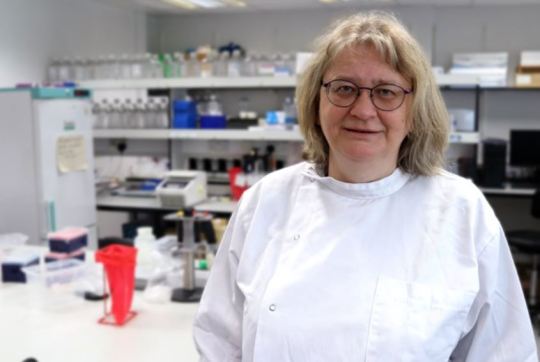
Zosia Miedzybrodzka, Professor of Medical Genetics at the University of Aberdeen and Director of the NHS North of Scotland Genetic Service, led the research that established the Westray link to the BRCA1 variant with Professor Jim Wilson from the University of Edinburgh.
Welcoming the launch of the pilot trial, Professor Miedzybrodzka said: “The NHS Grampian genetics clinic and lab teams are delighted to offer this pioneering new service to Westray residents which will improve care and save lives. I am grateful to every single person that has made this pilot happen. We are setting up a system that will hopefully extend to the rest of Orkney and Scotland as soon as funding allows.”
Gina Rendall, Operations Manager at the Westray Development Trust, is among those planning to take part in the testing pilot. She said: “When the link to the variant was discovered the news had a deep impact on our small community and as a Trust we are delighted to offer the funding which means that members of our community can be tested and supported by Zosia’s team. I’m really proud to be from Westray and of the Trust’s pledge to support the pilot.”
Professor Nick Fluck, Medical Director for NHS Grampian commented: “Our genetic counselling team has done an outstanding job of fielding more than 1,000 calls and emails about this important new discovery and the roll-out of further testing will mean our researchers will continue to contribute to world-leading knowledge in this field. We are very pleased to be working alongside the University of Aberdeen and partners on this piece of work.”
Meghan McEwen, NHS Orkney Board Chair, said: “The pioneering work of the Grampian genetics team has done an incredible amount of work to ensure women with a Westray-born grandparent are able to access genetic counselling and their own risk factors around this discovery.
“The primary care team in Westray and NHS Orkney has done a wonderful job in providing support and information as part of this effort and I am extremely proud of our services and our community for responding so quickly.”
Dr Kate Done from the Westray GP Practice added: "The team at Westray GP Surgery are very excited to be able to support this project. It's a great opportunity to help prevent these serious diseases amongst our patients, and hopefully the wider population in times to come."
Kay Johnston, Clan Cancer Support’s head of cancer support services said: “Clan has been delivering a dedicated drop-in service in Westray since April, following the publication of research concerning the BRCA1 gene variant, to ensure we could provide confidential support to the community.
“We welcome this testing pilot trial for the gene variant and will continue to support any individuals on Westray who are worried about their own results or a loved one who has been affected.”
A series of FAQs and short video explainers which are available on NHS Grampian’s website: www.nhsgrampian.org/BRCA1.
0 notes
Text
i've moved my spotify account and made new playlists so here's all my arthuriana playlists up-to-date
#playlist#arthuriana#arthurian legend#king arthur#guinevere#mordred#lancelot#morgause#lancelot/gawain#galadred#Spotify
201 notes
·
View notes
Text

April 9th 1283 saw the birth of Margaret, Maid of Norway.
Another long post, but I think it's important that we understad how Margaret became such and important figure in our history during her tragically short life.
Historians debate whether Margaret counts as a Scottish monarch and Scotland’s first queen because she was never inaugurated. However, she was named heir by her grandfather was the unfortunate Alexander III, and was accepted as such, so her linaege is not in question, the fact is she was never crowned.
Margaret, known as the Maid of Norway was the daughter if King Eric II of Norway and Margaret of Scotland. By the end of the reign of her grandfather King Alexander II of Scotland, she was the only surviving descendant and was recognised as heir presumptive. He died in 1286 and his unborn child with his wife Yolande, died stillborn,leaving Margaret to inherit the crown. As she was only three at the time, she remained in Norway for four years before starting the journey to Scotland.
Her father and other Scottish leaders attempted to negotiate a marriage between her and Edward I of England’s son, eventually sending her to Scotland in September of 1290. She died in Orkney on her way and sparked a succession dispute which would last a number of years.
south-eastern Norway and grew up without her mother who died in childbirth. Her father, who was just 15 at the time, was advised to place her in the custody of the Bishop of Bergen, where she was raised. Now that she was in Bergen, there began a race to secure an advantageous marriage.
Once Alexander III became aware that Margaret was his only surviving descendant, he had all thirteen earls, 24 barons and three clan chiefs come to Scone to swear an oath of allegiance to her as his successor should he die without leaving a son or daughter. Following his unexpected death, Scottish magnates gathered to discuss the future of the kingdom and chose six regents to govern the country in the absence of an heir. At this time, Queen Yolande, Alexander’s second wife was pregnant and it was assumed that this child would be the next monarch rather than Margaret. However, Queen Yolande lost the baby and King Eric sent a representative to Scotland to claim the kingdom for his daughter. Opposition from Robert Bruce, among others, led him to make the decision not to send Margaret straight away.
In 1289, referring to his daughter as Lady Margaret and Queen Margaret, Eric began a negotiation with King Edward of England. As she was still under the protection of her father, the Scottish could only observe these negotiations. The Scottish guardians, along with Bruce, made their way to Salisbury where they met with English and Norwegian envoys to further discuss the Scottish throne. The Treaty of Salisbury stated that King Eric had handed over power to Edward I to intervene on Margaret’s behalf. The treaty agreed that Margaret was to be sent by 1st November to England and once the Scots could assure Edward that there was peace in their kingdom, she would be released to them. Edward was also allowed to choose her husband, though her father was allowed to veto the choice if he wished. The pair ended up seeking papal dispensation so that Margaret could marry Edward’s son, something that the Scottish guardians agreed.
Negotiations regarding the marriage continued into 1290 between England and Scotland with plans for a personal union between the two counties. However, diplomatic difficulties delayed Margaret’s arrival. A further treaty was agreed in July of that year that agreed that Scotland was to remain fully independent, despite any personal union and that Margaret alone would be inaugurated.
Margaret eventually set sail in August 1290 on board one of her father’s ships, though he did not accompany her. Her former guardian, the Bishop Narve was present however. It is noted that she began her journey in good health but became ill during the journey causing the shop to land in Orkney to find medical assistance. She continued to suffer for up to a week before dying in September in the arms of the Bishop. The Scottish magnates were informed the following month and returned her body to Bergen, where her father insisted on an open casket to confirm her identity. She was then buried in the north wall of Christ Church which has since been destroyed.
Margaret was the last legitimate descendant of King William the Lion. After her death, thirteen men laid claim to the throne, including Robert Bruce (The Competitor) and John Balliol. Her father King Eric also half heartedly attempted to claim the throne but died in 1299. In 1301, a German woman claimed that she was the real Margaret, however, she was imprisoned and burned at the stake.
9 notes
·
View notes
Photo

Just the Orkney clan who strives to bond over something other than murder and family trauma.
180 notes
·
View notes
Text
Thought for the day

I love Edinburgh Crowley so much. David really lets his freak flag fly all over this one. He pulls out *all* the accents ( I was never sure if NG was trolling him or not). The huge grins, almost winking at the audience everytime he has a clever line. And this one in particular kills me.

There are at least 100 different versions, too. Proper ones and posh ones, Edinburgh vs Glaswegian, Orkney vs Highlander, and on and on. Sgt Shadwell's. Some of them are unintelligible to anyone outside the clan. Many contain vocabularies of their very own.
"An' prithee which'un o'deh Scottish accen's deeya wan'a'muh tae doo, laddie?" Is how I'm sure David answered that question.
#good omens#edinburgh#accents#crowley through the ages#trolling#people pay good money for a nice set o'gnashers
12 notes
·
View notes
Text
I feel like an Arthurian adaptation of Gannibal (the drama and the manga) with Lancelot and Gawain would work.
Lancelot is a cop with a troubled history, assigned to a rural village with its dark secrets. He's also a single dad who's struggling to raise Galahad. Thankfully, he has the support of his friendly, elderly neighbor Faye and superior Bedivere (who's married to a grumpy but helpful Kay)
Bedivere tells Lancelot to steer clear of the Orkneys, the town's oldest clan and rumored cannibals. And yet, Lancelot can't help but be drawn to the Orkney's eldest son -the mesmerizing, green-eyed Gawain.
Basically Lancelot smooches people he's not supposed to. And there's also dead people. Lots and lots of dead people.
Bonus: paranoid Pellinore whose son went missing years ago, and Mordred befriending Galahad at school. Also, creepy twins Gaheris and Gareth
7 notes
·
View notes
Text
Gareth was the brother who chased the others with a knife. So was Gaheris but he stopped the day he felt the terror of a younger sibling coming at you with a sharp object.
5 notes
·
View notes
Text
While I’m working on asks, I’d to introduce some of my favorite GSA fan characters (aka representations of some of my favorite characters from the Arthurian mythos) - the Orkneys!!!
From left to right: Gawain, Agravaine, Gaheris and Gareth.

Descriptions:
All - The Orkney brothers are King Arthur’s nephews. All of them fight for the GSA for the sake of their uncle. Unfortunately, though, none of them survive the war against Nightmare.
Gawain (he/him) - The oldest of the Orkney brothers, the Solar Knight. He has powers that he draws from the sun which make him stronger during the day and grant him nigh invincibility, superior strength and Beam magic at noon (depending on what planet he’s on, of course). He is in charge of intaking, training and disciplining new GSA recruits, as well as leading them in battle and fighting on the front lines. A confident and talkative man who takes himself and his duties very seriously. Cares for his brothers above all else.
Nightmare ended up claiming Gawain while in a fit of rage and despair over the loss of his brothers. He was corrupted and turned against the rest of the GSA similarly to Jecra. Lancelot was the one who finished him off.
Agravaine (he/she/they) - The second oldest sibling, Knight of the Eclipse. Before the Ninja clan was accepted into the ranks of the GSA, Agravaine was at the head of stealth missions, and worked with the Ninja clan once they appeared. Arrogant and self-assured, but cowardly and afraid of getting hurt. Their bark is much, much worse than their bite.
Agravaine became very close with Yamikage while sharing a post with him. When he decided to turn on the GSA, Agravaine went with him, seeing that they were on the losing side. In their first battle against the GSA, Lancelot killed them before they could escape.
Gaheris (they/them) - Second-youngest of the Orkneys, the Crescent Knight. Gaheris leads the archery and artillery force of the GSA, and is a famed archer themselves. Gaheris is quiet and unassuming, and prefers to remain a mystery. Having a mysterious aura is how they keep their awkward nature to themselves.
At one point during the war, Queen Guinevere was captured by Nightmare, and an assassination was planned. While the greater part of the GSA was gone, split between the rescue of the Queen and other fights on other planets, the main GSA base was invaded. Gaheris and their youngest brother, Gareth, were killed in the attack.
Gareth (he/him) - The youngest Orkney brother, the Stellar Knight. Gareth leads the heavy armor force of the GSA, and also cooks sometimes. His entry into the GSA was delayed because he was too young to leave home when his brothers did, so he spent some time as a dishwasher before becoming a knight. (He disguised himself so Arthur didn’t make him a knight due to nepotism.) Bubbly and outgoing, friendly to everyone he meets. He’s a bit absent-minded, but he is surprisingly socially aware.
(bonus: designs of them as borbs below the cut. just to assure that yes this is a kirby post even though i am an arthuriana nerd)

#not ask#character reference#kirby oc#galaxy soldier army#riddle's fcs#gawain (oc)#agravaine (oc)#gaheris (oc)#gareth (oc)
33 notes
·
View notes
Text
•°Blood Feud°•
A smaller sketch detailing the rather unfortunate conflict between the Orkney Clan. Aggrafayne prided himself on being everything their father desired in a son - in a potential head of the family. But despite his active effort to be exactly what their father wanted, he was never acknowledged in light of his older brother. Rage and resentment simmered beneath the surface for years, only to boil over at the worst possible time.
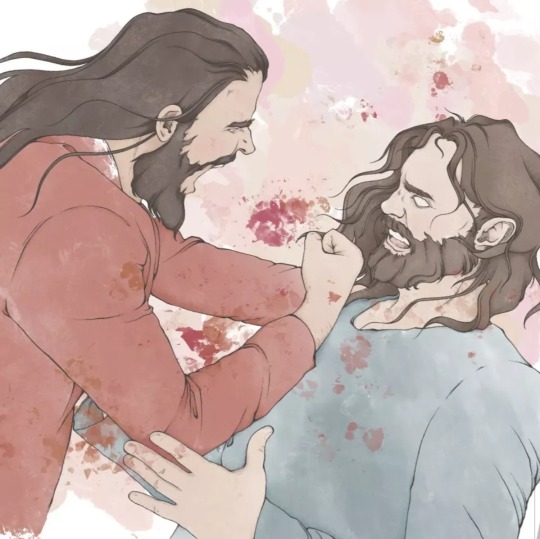
#arthuriana#arthurian legend#king arthur#arthurian oc#gawain#gwalchmei#aggrafayne#aggravaine#sir gawain#sir aggravaine#camelot#sketch#drawing
16 notes
·
View notes
Note
can I ask what it so inaccurate about Outlander? I ask in good faith it just always struck me as one of the more historically accurate shows
The topic of Scottish identity after 1689 through the Jacobite rebellions and then emigration from the Highlands and Islands to North Carolina was literally my master’s thesis topic lmao So I will try and keep this as brief as I humanly can when I quite literally wrote a book on it.
My primary issue with Outlander’s historical inaccuracies is my main issue with 99% of historic Scottish media,in that it grossly romanticized and subverts modern conceptions of nationality and patriotism on to people who did not think nor operate that way. Outlander is guilty of what nearly anything about the Jacobites does in that it totes them as Scottish nationalists and protectors of Gaelic culture against the forces of invading Anglicism. Media loves to portray them as Catholics,fierce Scottish patriots,and kilt wearing Highlanders fighting for their god given Celtic freedom.
The reality is far more complicated. Scots didn’t really conceive of themselves existing beyond the lens of British,even the Jacobite extremists. And by 1745 even Jacobites weren’t so much for the Stuarts and the ideal of Scottish separatism and individualism,nor were they majority Catholics,nor were they a bastion of Gaelic purity against the evils of the English Empire. The Scots were very much a part of the British Empire and were participants of its expansion,colonialism,and conceptions of identity. Scots did consider themselves to be Scottish,but also British,but also what county they were from,or what part of the highlands or islands. Of course the more remote you got the more distance and separation in how closely they considered themselves a part of Britain. There’s an account from a famous travel journal of a man visiting the Orkney islands like 7 years after William of Orange was on the throne,where the local islanders had no idea the Stuarts weren’t on the throne anymore and that rulership had changed. So of course place and key details of remoteness played a huge part in identity.
But the fact remains that even the Jacobites during this period weren’t like “I’m going to fight for Scottish independence from Britain and I love my motherland for my roots of Gaeldom and I’m going to wear my kilt as a symbol of my culture against the oppression of the English” *bagpipes plays* Many Scots did want separation and didn’t like the 1707 union,and yes after 1745 traditional highland culture was restricted. But we must also remember that even amongst Scottish separatists the Jacobites were considered extremists,and very few actually believed Charles should be king. Many simply wanted the separation of Scottish parliament,and for many others it was the same cries of unlawful taxation and oppression of a foreign king heard in the North American colonies only a couple decades later. The reality is that often that rebellion was born from political feuding,rather than cultural.
The romanticism comes from Walter Scott initially who in the early 1800s became famous for his romantic novels about the Scottish highlands and the Gaelic fight for freedom. Literally almost all of our modern conceptions of the 18th century Highlander comes from Scott and WOOL MILLS in LONDON in 1800 who invented the idea of clan tartans and the kilt as a symbol of Clan allegiance and Scottish nationalism. Identity in the 18th century was a murky and complicated thing,and the conceptions of Scottish and highland and specific clan affiliation and specific family houses were not necessarily in opposition to the conceptions of Britishness,nor was the idea of Anglicism conceived of being inherently bad or a corruption of Gaelic culture. Many hated the English sure,but the majority did not. The idea of protecting and revitalizing traditional Gaelic culture was a later invention,and while certainly many highlanders and islanders were proud of their culture and ways of life,those ways of life existed more from isolation and local evolution of identity and culture,rather than a universal highland and island conception of Scottishness or Gaelicness.
So in all,Outlander projects modern nationalism and romanticism on to the Scottish highlander. And yes they’re romance books,but the continuation of we as modern people projecting our own ideals and values to people in the past is a rampant issue for historians. It’s the same as our romanticism of the American Revolution and the complete false narrative of history that stems from that. The result is nearly an entire country who does not truly understand why our society exists as it does now. If you view the Jacobite rebellions or the American Revolution through a lens of brilliant patriots and nationalists fighting for their culture and freedom than there’s literally no way you can understand your own government or the history of your country accurately. Romanticism blinds the general public to the nuances and reality of history,and that reality grounds our political present and the current issues we all face.
#scottish history#history#tag talks#like ted talks but more obnoxious#outlander#anons#long post#not Star Wars
98 notes
·
View notes
Text
nurse she's out again
#sorry sorry one day i'll stop making playlists (a lie)#arthuriana#arthurian legend#the orkneys#playlist#oforkney.txt#Spotify
14 notes
·
View notes
Text
Settlers of Catan's expansion, Cities and Knights of Catan, being at a lower general level of technology, (they don't have guns and they're feudal and fight what appear to be either boating mongols or possibly vikings), but the lack of preexisting cities and settlements in Base Catan, (people just show up and start building) implies that at some point, something happened to Catan that left only the Robber still standing.
The rules of C&KoC, the robber not activating until the barbarian ship come for the first time, implies that the robber is either related to the barbarians, or possibly represents a levy group turned bandit after the devastation of the first raiding of Catan.
Interestingly, Base also lacks the more processed "commodities" of C&K, which implies that Catan is a colony for raw resource extraction in Base, rather than a truly independent organization. However, you can't get aid from your home power in Catan, which implies you're something closer to a Catan Company, essentially a private business that has to sell resources to have others imported, and often at a markup.
The inhabitants of Catan in C&K don't look significantly different from the Settlers, but the Barbarians, apart from hairstyle and armor, ALSO don't look that different. Further, Seafarers of Catan (the other expansion) says that there is gold on nearby islands, and it's known about by the settlers. Interestingly, the Barbarian Raid timer tracker uses terrain with the same appearance as the gold-rich islands to represent where the barbarians come from. And it is only two hexes long. That may be metaphorical, but what if it's a literal distance? What if the Barbarians are based on the nearby islands? Further, Catan knows the Barbarians are coming, even before they do. This means they must have some reason to think they're at risk.
This, plus the knights armor types in contrast to the Barbarian equipment, allows us to draw some interesting conclusions about Catan's history.
Catan is an archipelago. Somewhere around 900, the Catan Archipelago was largely united under a High King, and the various clans of Catan did well enough for themselves. (Those are the starting settlements.) Catan traded with the outside world its plentiful ore, clay, textiles, and wood, and had smaller nearby islands rich in precious metal. Then, the barbarians came, and captured the smaller, much less inhabited islands in order to have a staging ground nearby to raid the wealthy and largely unprotected Kingdom of Catan, as Orkney and the Hebrides were for the Vikings raiding the various Anglo-Saxon and Brittonic kingdoms. However, they did not bring tools with which to extract the precious metals from the mines (they clearly have mining capabilities, they have so much armor they must get it from somewhere.) At this point, the title of High King of Catan is largely ceremonial, the clans mostly do their own thing, but they rarely fight with each other. Then, the first Barbarian raids on the Catan mainland start. This results in the peace between the clans breaking down somewhat. The robber being controlled by the player on rolling of a seven and being able to be kicked by a knight means that the robber is probably actually a mercenary form of the Barbarians, a group of them who stayed after the first raids and adopted some Catanic customs, to sell their raiding services as mercenaries to the various clans, which are at this point actively in competition to be declared absolute rulers of Catan and to have the others as permanent vassals. The barbarians, around 1100, discover gold in the outer islands and begin to come in greater numbers to take advantage of that, as Catan improves its knights and builds more cities, eventually coming to knights in Brigandine and great helms in the 1300s. One of the clans wins, and is the High King of Catan, but with the help of the Robber (a mercenary band of raiders which has only grown over the last few centuries) the victory is short-lived. At this point, a full invasion of Catan takes place, with the help of the robbers, and it's a grueling stalemate for several decades. Most survivors of the Kingdom of Catan leave the island for other places, and the Barbarians eventually deplete most of the accessible gold reserves of the outer islands and begin to leave them. The big island of Catan maintains a small population throughout the next few centuries, mostly of a new culture made up of the survivors of both sides of the war. But then, their population collapses as a plague sweeps through the island, leaving few survivors. It's now the mid 1700s, and Catan, while it's remained on the naval charts, has largely been forgotten. However, some people, probably descended from the Catanic Diaspora, do remember the stories of the gold in the outer islands, and set sail for Catan, some with more modern prospecting equipment. They discover that there's still gold in the outlying islands, though it's rather less accessible than it used to be (thus why it's associated with much rarer rolls.) Their arrival was what brought the plague to the small, isolated population of Catanic people who remained, ultimately wiping out over 70% of the population left on the island out. When the various nations send out their Catan Companies, they arrive on the island to find the Robber and the Pirate already there. The Robber and the Pirate are the surviving old Catanics, returning to their mercenary ways. Most of the settlers who come to Catan are from the Catanic Diaspora.
This also implies a future for Catan. In the mid 1800s, after a major dispute involving military buildup on the island, the countries that run the companies agree to cede Catan to the one most established (the one with all the victory points.) The Robber and the Pirate either stop their activities or are killed. In the late 1800s, the Catan company is dissolved and Catan becomes a full-blown colony. Catan develops a nationalist movement throughout the next few decades, though it's not allowed to actually become independent until the 1940s, when the end of WWII and rebuilding efforts on the mainland causes the country running the Catan colony to withdraw its administration. Catan's gold mines are at this point depleted, and most of its ore has been mined. The desert is of poor quality for concrete, the forests are mostly logged, and the grain and wool production is thoroughly outclassed by other countries, which also have a strong industrial base that Catan just doesn't. Catan soon becomes one of the poorest countries in the world, barely scraping by as a tax haven, most of the population subsistence farmers or brickmakers, Catan's only real remaining export. Eventually, Catan comes to an agreement with another power, and becomes a penal colony. Catan closely resembles Narau after the phosphate industry collapse, (except rather geographically larger), right down to being a one-party democracy, because everyone knows every politician's stance, they don't need to signal by joining another party. It remains to this day a relatively poor nation. The mercury used in the gold mining industry still taints the land and water. 90% of island residents show signs of chronic mercury poisoning, and the most common cause of death is kidney failure.
in 1993, during the filming of the unsuccessful action-thriller movie Island Hawk, the levy around an outlying island's long-abandoned gold mines breaks, causing a visually spectacular flood. The incident is caught on camera. The footage is widely viewed, and brings fame and attention to Catan for the first time in decades. The producers of Island Hawk, however, lay claim to the footage and today it is nearly as difficult to find as footage from the movie itself. In 1995, after watching the footage, Klaus Teuber is inspired to research the place it was shot. He then designs the board game, Die Seidler von Catan, based on the history of the archipelago during the Company years. Later expansions bring in the High Kingdom of Catan's history to the game.
Catan to this day is largely ignored by the international community. It has a small airport, but no one much cares to visit Catan. The climate isn't Tropical or Mediterranean, and few people willingly go to an isolated, fairly cold island for a vacation when there's other options. Archeologists occasionally come to dig sites in Central Catan, to look at the few remaining ruins of the High Kingdom Era, but they rarely stay long. No one stays in Catan long if they can help it. Not anymore.
14 notes
·
View notes
Text

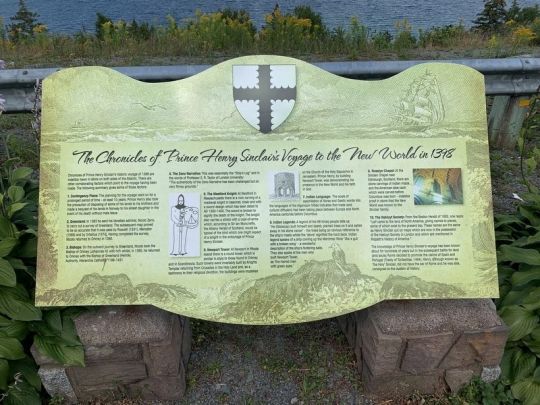
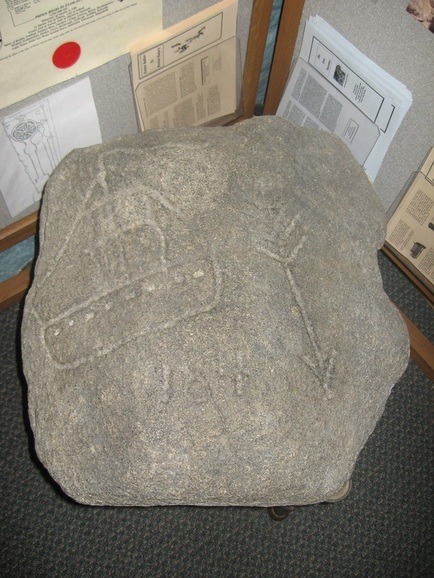
On June 2nd 1398 Prince Henry St Clair is said to have landed in Nova Scotia, having sailed from Orkney, this was 92 years before Columbus happened upon The Americas
Prince Henry Sinclair was the son of Sir William Sinclair. Prince Henry became Jarl/Earl of Orkney in 1379. Henry was entitled to the position by way of his mother, Isabella, Countess of Orkney, Scotland.
In 1398 Prince Henry Sinclair was the commander of a fleet of ships that explored the North Atlantic Coast of North America (as yet unproven, but with unauthenticated evidence) Henry took the fleet in search of timber to begin a ship building trade. He sailed under the Norwegian Flag, as the Orkney's were an Earldom of Norway at this time.
During the visit to North America, Sinclair built a new long ship, and sailed it back to the Orkney Isles. During this visit to North America, he explored an area known today as Westford, Massachusetts. While visiting Westford one of the Knights of his military contingent known to have been Sir James Gunn died. A monument to Sir James was “drawn” by punching holes in a rock wall outlining a Templar Knight... This authenticated carving is known today as:
“the Westford Knight .”
The Clan Gunn uses this semi-factual "legend" to claim that their Sir James was a discoverer.
Although this voyage was recorded by Zeno, his pilot, the records were not taken as facts. Zeno was of Venetian ancestry, and when he returned to Venice, the people could not even believe that there was a place like the Orkney's let alone North America! The world was a lot smaller back then lol.
Sinclair returned to his home in Roslyn, when he discovered that the English were raiding his barony. In the rush to battle to defend his people, and the Highland Clan, he was mortally wounded. Prince Henry was buried in his armor, at the site of the present day Roslyn Chapel. Roslyn Chapel, as those who were there can attest, was built in the early 1400's and has carvings in its detail work that are unmistakably rendition of the corn plant (maize) and the aloe cactus , both of which can only be found in that time period in North America.
From Mysterious Britain: "The Knight Templars and Rosslyn Chapel The Prince of Orkney was undoubtedly involved in the Order of the Knights Templar, who were forcibly disbanded in 1307, although they continued on in one form or another. The Templars have become embroiled in many legends of mystical significance.
One of the main legends is they were supposed to have in their possession the Holy Grail, and it has been surmised that the chapel is the hiding place for this and other religious treasures, including a fragment of the holy rood, the cross of the crucifixion. My mother told me that the Holy Grail may be in Rosslyn Chapel when I was a child at primary school, she said that it may have been hidden in the Apprentice Column in the chapel. Dan Brown wrote about this about 30 years after my mum told me the story.
According to legend the actual hiding place for these artefacts is the vault under the building. The vault actually contains the remains of the Sinclair ancestors, interred in full armour as was customary until one of their wives objected to the practice in the 1700's.
Some of the carvings within the chapel suggest that there was an early contact with the New World years before the 'discovery' of America by Columbus. The carvings depict what is thought to be an American Cactus and Indian Sweetcorn, things that should not have been known when the chapel was created. Perhaps the Templars, who travelled far and wide discovered America before Columbus. "see Clan Sinclair's' Trial in 1997 to determine whether Jarl Henry Sinclair "did it". From The New World Celts : "Prince Henry Sinclair, Earl of Orkney leads the last Norse-Celtic Atlantic Expedition, landing in New England in 1396, almost one hundred years before Columbus.
Affiliated with the legendary Knights Templar, stories persist that St Clair buried remarkable treasures in Nova Scotia, possibly the Grail itself. In 1398, Sir John Gunn died in Massachusetts, where his rockcut memorial and arms may still be seen, as seen in the third pic.
I have to say that a majority of historians vigorously dispute that this journey ever took place, I'll post a link below with a wee bit more info, you can make up your own minds.
37 notes
·
View notes